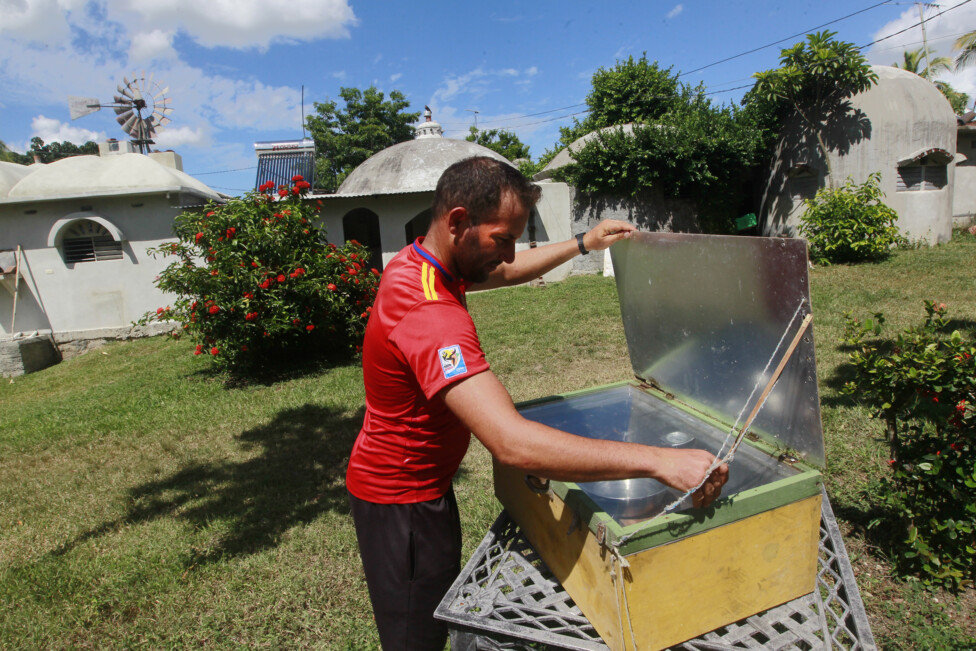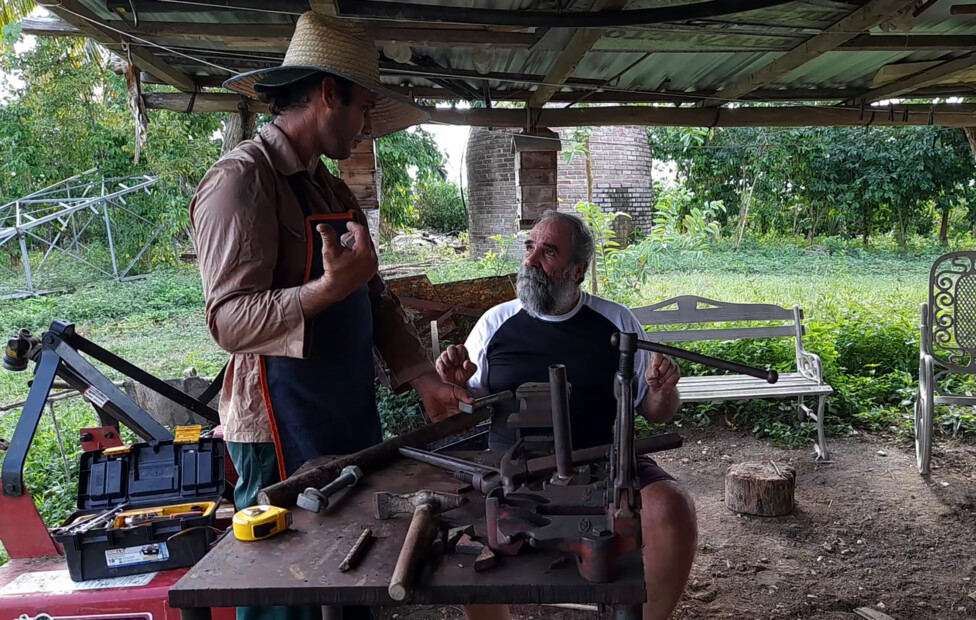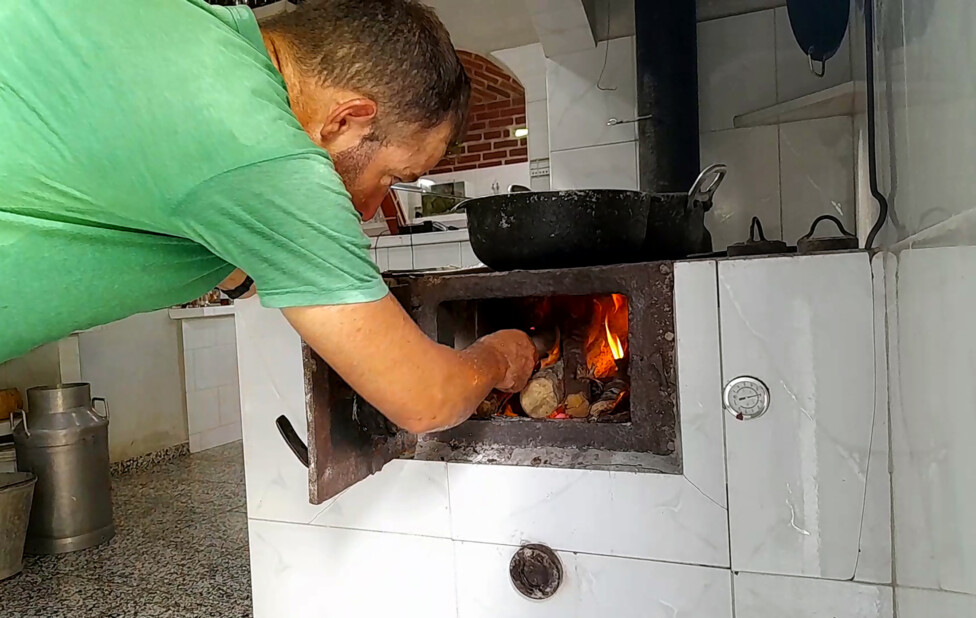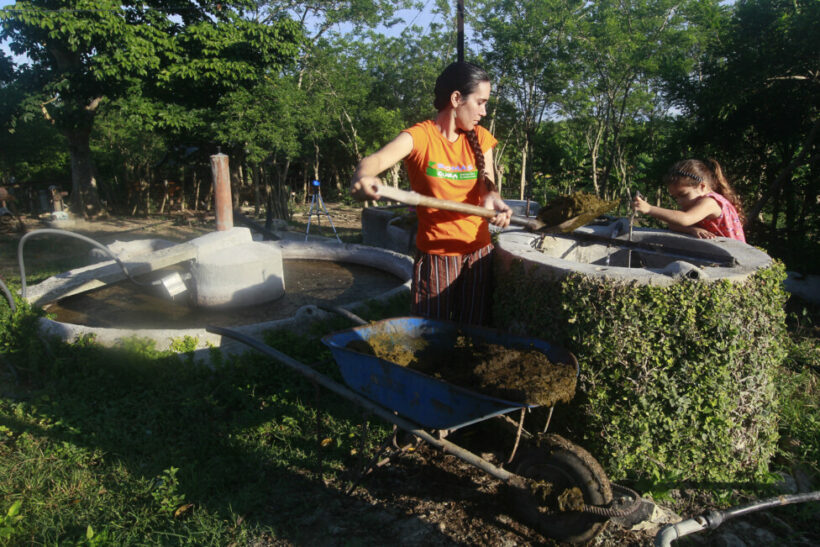Combining technologies and innovations to harness the potential of solar, wind, hydro and biomass allows Finca del Medio to be a leader in Cuba in the use of clean energy, which is the basis of its agro-ecological and environmental sanitation practices.
By Luis Brizuela
Renewable energy sources are used in multiple daily processes such as electricity generation, lighting, water supply, irrigation and heating, as well as in cooking, dehydration, drying, baking and refrigeration of foodstuffs.
“We started with windmills on artesian wells and hydraulic rams to move water. That gave us a consciousness of how much energy we needed and to expand its use,” said farmer José Antonio Casimiro, 65, owner of this agro-ecological family farm in the centre of this elongated Caribbean Island.
The farmer valued the help of his 41-year-old son, who has the same name and surname as him, in setting up the two windmills at Finca del Medio, during the days when IPS visited the installation and shared the activities with the family.
“There was no one to assemble or repair them. We both had to study a lot, and we learned to do a lot of construction things as we went along and perfected the techniques,” Casimiro Jr. said of the equipment, now inactive but capable of drawing some 4,000 litres of water daily from the water table.
When the rains come and the volume of the 55,000 cubic metre capacity dam increases, the hydraulic ram comes to life. The device diverts about 20,000 litres of water to a tank with a capacity of 45,000 litres, 400 metres away and 18 metres above the level of the reservoir.
“The ram uses the water pressure itself as its only energy. Taking it to the highest point makes it easier to use the slope for gravity irrigation, or to fill the animals’ water troughs,” explained Chavely Casimiro, 28, the youngest daughter of married couple José Antonio and Mileidy Rodríguez, also 65.
“More incentives, better policies and financial support are needed so that farming families have enough energy for their work and improve the comfort of their homes and quality of life”: José Antonio Casimiro.
A plastic artist with the same farming “gene” as the whole family, Chavely highlighted the twenty or so innovations made by her father to the hydraulic ram, in order to optimise water collection.
Other inventions speed up the assembly and disassembly of the mills for maintenance, or in the event of tropical cyclones.
“We have been replacing the water supply with solar panels, which are more efficient. They can be removed faster (than windmill blades) if a hurricane comes. You can incorporate batteries and accumulate the energy,” Casimiro said.
In addition, he said, “let’s say a windmill costs about $2,000. With that amount you can buy four 350-watt panels. That would be more than a kilowatt hour (kWh) of power. You buy a couple of batteries for $250 each, and with that kWh you can pump the equivalent of the water for about 10 windmills.
But for the farmer, the windmills have more importance than what they generate. “It would be good if every farm had at least one windmill. For me it is very symbolic to see them pulling water,” he said.
 Lorenzo Díaz, husband of Chavely Casimiro, uses a solar oven to cook food. In the background, a windmill and a solar heater are other technologies that harness the potential of renewable energy at Finca del Medio, in central Cuba. Image: Jorge Luis Baños / IPS
Lorenzo Díaz, husband of Chavely Casimiro, uses a solar oven to cook food. In the background, a windmill and a solar heater are other technologies that harness the potential of renewable energy at Finca del Medio, in central Cuba. Image: Jorge Luis Baños / IPS
Innovations
Located in the municipality of Taguasco, in the central province of Sancti Spíritus, some 350 kilometres east of Havana, Finca del Medio is a family farm model based on permaculture, agro-ecology and agricultural production, with the main use of clean energy.
In 1993, Casimiro and Rodríguez with their children Leidy and José Antonio – a year after Chavely was born – decided to settle on their paternal grandparents’ 13-hectare farm, with the aim of reversing its deterioration, soil erosion and installing perimeter fences.
The erosion of the land was due to the fact that in the past the farm was dedicated to tobacco cultivation, with an overexploitation that degraded it, and also after it had spilled out into abandonment, as well as the house.
The eldest daughter is the only one who does not live and work on the farm, although she does spend time there, and a total of ten family members live on the farm, including four grandchildren, and all the adults either work on the farm or spend time helping with different tasks.
With the help of context-specific innovations in technology and empirical and scientific knowledge, the family is self-sufficient in rice, beans, tubers, vegetables, milk, eggs, honey, meat, fish and more than 30 varieties of fruit. Of the staple foods, only sugar and salt are not produced.
They trade all the surplus from their production, including cow’s milk for which they have specific contracts, and they are also promoting agrotourism, for which they are making further improvements to the facilities.
At Finca del Medio, a system of channels and ditches allows water from rainfall to infiltrate, prevents the topsoil from being washed away and conserves as much of the liquid as possible for subsequent irrigation.
These innovations also benefit neighbouring residents by mitigating flooding and feeding the water table, which has restored the sap to once extinct wells.
The construction of the house is also a “child” of technology solutions to the scarcity of resources such as steel, which led to the design of dome-shaped roofs made of mud bricks and cement.
The design aids in rainwater harvesting, improves hurricane protection and improves ventilation with cooler spaces, which reduces the need for air-conditioning equipment and amplifies savings.
Along with food production, the new generations and members of the Casimiro-Rodriguez family promote education and socialisation of good agricultural and environmental practices.
Students from nearby schools come to the farm to learn about these practices, as well as specialists in agroecology and people from different parts of the world who are interested in sharing the experience. Meanwhile, several members of the family have travelled abroad to give workshops on agroecology and permaculture.
 Farmers José Antonio Casimiro and his son of the same name talk in the mechanical workshop at Finca del Medio. The two have developed innovations for the use of windmills, the hydraulic ram and biodigesters, as well as implements for tillage. Image: Jorge Luis Baños / IPS
Farmers José Antonio Casimiro and his son of the same name talk in the mechanical workshop at Finca del Medio. The two have developed innovations for the use of windmills, the hydraulic ram and biodigesters, as well as implements for tillage. Image: Jorge Luis Baños / IPS
Solar and biogas potential
On one of the side roofs of the house, a site with 28 photovoltaic panels provides about eight kWh, connected to batteries. The stored energy guarantees domestic needs during power outages that affect the island due to fuel shortages, as well as breakdowns and maintenance of its ageing thermoelectric plants.
In addition, three solar heaters with a capacity of 380 litres add to the supply in the house.
Next to the kitchen, two fixed-dome biodigesters contribute another renewable fuel, biogas, composed mainly of methane and carbon dioxide from the anaerobic decomposition of animal manure, crop waste and “even the black water from the house, which we channel so that this waste does not contaminate the environment,” Casimiro said.
Because of the current lack of sufficient manure due to the reduction in the number of cows, only one of the biodigesters is currently operational, with about seven metres of biogas per day, enough for cooking, baking and dehydrating food.
The inventive family came up with a mechanism to, without emptying the pond with water or stopping biogas production, extract solids from the bottom that are used as biofertilisers, as well as hundreds of litres of effluent for fertigation (combination of organic fertilisers and water) of the crops, by gravity.
Both the installation of the biodigesters, the photovoltaic solar panels and one of the solar heaters were supported by the Swiss Agency for Development and Cooperation (Cosude) and the Indio Hatuey Experimental Station of Pastures and Forages with its Biomas-Cuba project, Casimiro said.
He also appreciated the link with other scientific institutions such as the Integrated Centre for Appropriate Technologies, also in the central province of Camagüey, focused on offering solutions to the needs of water supply and environmental sanitation, and essential in the installation of the hydraulic ram.
The farmer said that the farm produces the equivalent of about 20 kWh from the combination of renewable energies, and if only conventional electricity were used for activities, the cost would be the equivalent of about 83 dollars a month.
 Lorenzo Díaz supplies firewood to an innovative cooker that allows Finca del Medio to efficiently cook food, dehydrate fruits and spices, heat water and treat meats for preservation, among other functions. Image: Jorge Luis Baños / IPS
Lorenzo Díaz supplies firewood to an innovative cooker that allows Finca del Medio to efficiently cook food, dehydrate fruits and spices, heat water and treat meats for preservation, among other functions. Image: Jorge Luis Baños / IPS
Efficient cooker
Located in the large and functional kitchen, the cooker covered with white slabs and a fireplace has undergone 16 renovations to make it more efficient and become another of the farm’s prides.
Fueled by firewood, coconut shells and other waste, “the cooker allows us to prepare food, dehydrate fruits and spices, heat water and treat meats for preservation, among other tasks,” Rodríguez stressed to IPS as she listed some of the advantages of this other “child” of the family’s ingenuity that supports her skills as a skilled cook and baker.
She noted that, along with the extraction of all the smoke, “the design makes better use of the heat, something that should be used in a sauna” that is built next to the kitchen, for the enjoyment of the family and potential tourists.
Casimiro is in favour of incorporating clean energy into agricultural processes, but, he said, “more incentives, better policies and financial support are needed so that farming families have enough energy for their work and improve the comfort of their homes and quality of life”.
Since 2014, Cuba has had a Policy for the Prospective Development of Renewable Energy Sources and their Efficient Use.
It is a matter of national security to substantially modify the national energy matrix, which is highly dependent on the import of fossil fuels and hit by cyclical energy deficits.
However, regulations with certain customs exemptions and other incentives to increase the contribution of solar photovoltaic, wind, biomass and hydroelectric energy in this Caribbean Island nation still seem insufficient in the face of the high prices of these technologies, the domestic economic crisis and the meagre acquisitive power of the majority of Cuban families.
Clean sources account for just 5 % of electricity generation on the island, a situation that the government wants to radically transform, with an ambitious goal that will be 37 % by 2030, something that is becoming increasingly difficult to achieve.






